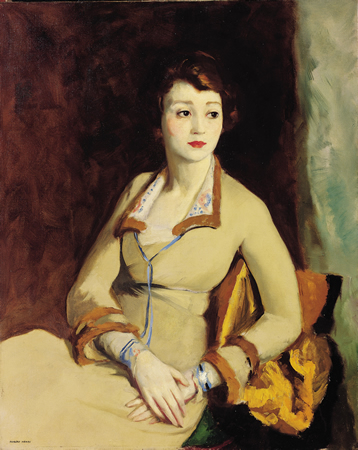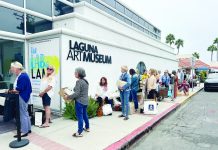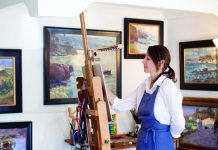A boy sits in a chair wearing a white shirt, brown pants with suspenders askew, and a bewildered expression. Named Sylvester, he’s African American, about 10 years old and clearly not accustomed to sitting still for a portrait.

On his first visit to California from New York, Robert Henri discovered the lad around 1914 selling newspapers in San Diego. A second painting shows him smiling broadly. Perhaps he had gotten used to the idea that this grown-up white man wanted to paint him, not something that anyone would have expected in those times.
Sylvester sat for three portraits, all of which will be on display at the Laguna Art Museum in a show titled “Robert Henri’s California; Realism Race and Region 1914-1925,” which opens to the public on Sunday, Feb. 21.
The show curated by San Diego art history professor and Robert Henri scholar Derrick Cartwright features mostly full figure paintings or portraits of California’s minority population and a solitary landscape (“On the Beach, La Jolla”) to show the environment that Henri came to appreciate as well.
“Robert Henri was one of the most important painters in modern American art; he was a force. He was the father figure of the Ashcan School, a firebrand and an anti-academic person,” explained Cartwright.
As one of the founders of the Ashcan School, Henri had painted grittier urban scenes of New York, but concentrated on people for the most part while traveling through the eastern United States and Europe.
When a student of his suggested that San Diego was much like Spain, he decided to travel west but found the environs vastly different. “He became smitten with California, especially the light, but became fascinated with the area’s ethnic minorities, Chinese, African-American, Mexican and Indian,” said Cartwright. In a period of three months, Henri produced 100 canvasses, but not all survived, he added.
Portraits of a Native American woman and man (“Tom PoQi…” and “Po Tse” respectively) illustrate his instinctive empathy with cultures unknown to him. “Machu” depicts a very young Chinese woman demurely looking away from the painter while the subject of “Tam Gan” is clearly older and looks both wary and melancholy.
Leaning left politically Henri wrote in the publication The Craftsman: “The people I like to paint are ‘my’ people, where ever they may exist… My people may be old or young, rich or poor, I may speak their language or I may communicate with them only by gesture…but wherever I find them….my interest is awakened and my impulse is immediately to tell about them through my own language–drawing and painting in color.”
Henri also traveled to Los Angeles where he drastically changed course when it came to subjects. While he had previously disdained socialites and the wealthy bourgeoisie, calling them “the up-to-date class,” he painted portraits like “Miss Louise Getz” or “Mrs. William Preston Harrison,” upper-class Caucasian women in their finery.
“When he painted in San Diego, he paid his subjects for sitting. In Los Angeles, they paid him,” remarked Cartwright.
“Robert Henri…” has been staged as a result of conversations between the museum’s Executive Director Malcolm Warner, who worked at the San Diego Museum of Art while Cartwright was a professor at UC San Diego. “We have known each other since 1990 and Robert Henri has been a research interest of Derrick,” said Warner.
“When I came to Laguna Beach, I seized the opportunity to gather paintings Robert made in California. Laguna Art Museum may focus on California art but it means more than artists living here on a permanent basis,” Warner said. “Robert did not just come here on vacation to paint a few pictures. He felt inspired to seek out and became fascinated by new subjects that California offered.”
Also noteworthy is the show’s accompanying catalog. The museum collaborated on the book project with former museum curator Mike McGee, now director of the Cal State Fullerton exhibition design and museum studies department, and his colleague, graphic design Professor Theron Moore. Design students Jodi Rae Schwausch, Alexander Small and Wendy Peng are largely credited with the book’s design.
“Mike approached us a while back about doing such a project as a case study for students. Since it’s expensive for a museum to produce catalogues, we appreciated the help of Cal State Fullerton underwriting the production,” said Warner.
“California Printmakers, 1950-2000,” featuring prints by artists better known as painters such as Ed Ruscha, Wayne Thiebaud and David Hockney, also opens Sunday.
Warner curated the exhibit of lithographs, screen prints, etchings and woodcuts from renowned studios like Tamarind Lithography Workshop, Gemini G.E.L and Cirrus Editions in Los Angeles and Crown Point Press in San Francisco. “Print making has unfortunately gone into remission, but it is a strong art form not to be confused with reproduction of paintings,” said Warner.
The museum’s upstairs gallery features “In Barcelona,” curated by Grace Kook-Anderson. In 1988 and ’89 artists including Peter Alexander, Larry Bell, Billy Al Bengston, Laddie John Dill, Craig Kauffman, Ed Moses, Eric Orr and Ed Ruscha were invited by the Spanish print workshop Polírafa Obra Gráfica to create a portfolio of prints. Sixteen prints gifted to the museum by Moses comprise the exhibition.




